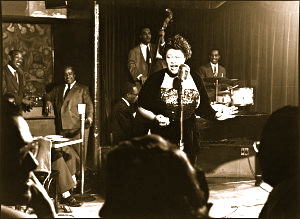The Royal Roost

Charlie Parker Quintet Live 1948: “How High The Moon”
Miles Davis – Trumpet, Al Haig – Piano, Tommy Potter – Bass and Max Roach – Drums. The Royal Roost, 1580 Broadway (at 47th Street), Peak years: 1946 to mid-’50’s.
 In 1942, a new sound began to be heard in New York City: snappy, staccato phrasing, harmonic leaps and rhythmic elasticity all taken at a breakneck tempo that favored 8th notes (and sometimes 16th notes) for maximum effect. By 1944, this sound that defined a doorway into the modern era of jazz had its heroes—Charlie Parker, Dizzy Gillespie—and a name: bebop.
In 1942, a new sound began to be heard in New York City: snappy, staccato phrasing, harmonic leaps and rhythmic elasticity all taken at a breakneck tempo that favored 8th notes (and sometimes 16th notes) for maximum effect. By 1944, this sound that defined a doorway into the modern era of jazz had its heroes—Charlie Parker, Dizzy Gillespie—and a name: bebop.
Bebop filtered into the clubs on 52nd Street—Onyx Club, Three Deuces, the Famous Door and others—where swing-era veterans like Count Basie, Pee Wee Russell and Eddie Condon could also be heard. But as bebop gathered momentum, it lacked its own home. An enterprising ex-saxophonist named Ralph Watkins—whose efforts at opening a jazz room in a chicken restaurant on Broadway were off to a stumbling start—was convinced by publicist/producer Monte Kay and DJ “Symphony” Sid Torin to try booking the stars of this new modern sound.
On a Tuesday night in 1948, the Royal Roost presented its first modern-jazz concert, showcasing a young, all-star lineup: Parker, Tadd Dameron, Miles Davis, Dexter Gordon, Fats Navarro and Max Roach. More than 500 fans showed up. Soon enough, the club adopted a second name, the Metropolitan Bopera House and proudly declared itself “The House That Bop Built.” With Symphony Sid pushing the concerts on his nightly radio program as well as broadcasting live from the venue, the Roost embraced its new focus.
 In late ’48, the stars of bop settled into the Roost: Gillespie with his big band, Parker with a quintet featuring Davis and Roach. The club soon spawned a record label, and Dameron, Bud Powell, guitarist Johnny Smith and even Harry Belafonte recorded for Roost. (Music entrepreneur Morris Levy took note and a year later opened Birdland and started the Roulette label.)
In late ’48, the stars of bop settled into the Roost: Gillespie with his big band, Parker with a quintet featuring Davis and Roach. The club soon spawned a record label, and Dameron, Bud Powell, guitarist Johnny Smith and even Harry Belafonte recorded for Roost. (Music entrepreneur Morris Levy took note and a year later opened Birdland and started the Roulette label.)
In September 1948, Miles Davis debuted a new project at the Roost: a nine-piece group developed at rehearsals in arranger Gil Evans’ basement apartment. Years later, when the influence of Davis’ breakthrough band was fully felt, the music was dubbed “The Birth of the Cool” and there was one more reason to enter the Royal Roost into the history books.
By 1950, saddled with a new, strong-armed partner intent on retooling the Roost as a new version of the Cotton Club, Watkins departed to open Bop City, which, despite an impressive neon marquee and a Broadway address, was short-lived. As modern jazz sprinted into the ’50s, the Roost became a fast-fading memory.
http://jazztimes.com/articles/17196-after-hours-new-york-s-jazz-joints-through-the-ages

